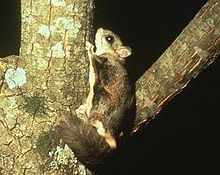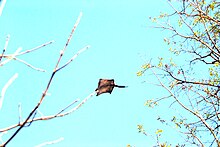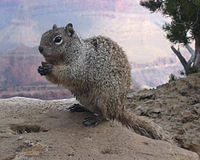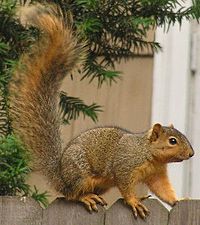
Squirrels are members of the family Sciuridae, a family that includes small or medium-sized rodents. The squirrel family includes tree squirrels, ground squirrels, and flying squirrels. Squirrels are indigenous to the Americas, Eurasia, and Africa, and were introduced by humans to Australia. The earliest known fossilized squirrels date from the Eocene epoch, and among other living rodent families, the squirrels are most closely related to the mountain beaver and to the dormice.

The western woolly flying squirrel is a species of very large flying squirrel in the genus Eupetaurus. It is native to northern Pakistan and northwestern India. It was long considered the only species in the genus until the description of two other species in 2021. Until recently, scientific knowledge of this rare species was limited to 11 skins collected in the late nineteenth century. However, recent research has confirmed that it remains in Kashmir. It is among the longest members of the family Sciuridae, and one of the biggest gliding animals known. Observations confirm that despite its size, it does glide effectively, like other flying squirrels.

The southern flying squirrel or the assapan is one of three species of flying squirrel found in North America. It is found in deciduous and mixed woods in the eastern half of North America, from southeastern Canada to Florida. Disjunct populations of this species have been recorded in the highlands of Mexico, Guatemala, and Honduras.

The northern flying squirrel is one of three species of the genus Glaucomys, the only flying squirrels found in North America. They are found in coniferous and mixed coniferous forests across much of Canada, from Alaska to Nova Scotia, and south to the mountains of North Carolina and west to Utah in the United States. They are light brown with pale underparts and grow to a length of 25 to 37 cm. They are proficient gliders but uncoordinated walkers on the ground. They feed on a variety of plant material as well as tree sap, fungi, insects, carrion, bird eggs and nestlings. They mostly breed once a year in a cavity lined with lichen or other soft material. Except when they have young, they change nests frequently, and in winter a number of individuals may huddle together in a shared nest. Unlike most members of their family, flying squirrels are strictly nocturnal.

Sciurinae is a subfamily of squirrels, uniting the flying squirrels with certain related tree squirrels. Older sources place the flying squirrels in a separate subfamily (Pteromyinae) and unite all remaining sciurids into the subfamily Sciurinae, but this has been strongly refuted by genetic studies.
Robot locomotion is the collective name for the various methods that robots use to transport themselves from place to place.

The three species of New World flying squirrels, genus Glaucomys, are the only species of flying squirrel found in North America. They are distributed from Alaska to Honduras. They are similar in many ways to the Eurasian flying squirrels in the genus Pteromys. Two species of New World flying squirrels can be easily distinguished on the basis of size and ventral pelage. Northern flying squirrels, Glaucomys sabrinus are larger and have belly hair that is dark at the base and white at the tip. Southern flying squirrels, Glaucomys volans, are smaller and have belly hairs that are completely white. Humboldt's flying squirrel is more difficult to distinguish from the northern flying squirrel where their ranges overlap. In fact, they were once considered conspecific. Humboldt's flying squirrel is considered a cryptic species. They are generally smaller and darker than northern flying squirrels.

Biswamoyopterus is a genus of rodent in the family Sciuridae. It contains three known species of very large flying squirrels, with B. laoensis being among the longest of all squirrels. They are distributed in forests in northeast India, southwest China and Laos. Despite their size, species in this genus tend to be very elusive; due to this, all of them have been described relatively recently. Additionally, they are easily confused with certain Petaurista giant flying squirrels that are more common and overlap in range with the rare Biswamoyopterus.

The Namdapha flying squirrel is a flying squirrel endemic to Arunachal Pradesh in northeast India, where it is known from a single zoological specimen collected in Namdapha National Park in 1981.

The red giant flying squirrel or common giant flying squirrel is a species of rodent in the family Sciuridae (squirrels). It is found in a wide variety of forest–types, plantations and more open habitats with scattered trees in Southeast Asia, ranging north to the Himalayas and southern and central China. One of the largest arboreal squirrels, all populations have at least some reddish-brown above and pale underparts, but otherwise there are significant geographic variations in the colours. The taxonomic position of those in the Sundaic region is generally agreed upon, but there is considerable uncertainty about the others, which variously have been included in this or other species, or recognized as their own species.
The Kashmir flying squirrel is a species of rodent in the family Sciuridae. It is monotypic within the genus Eoglaucomys. It is found in Afghanistan, India and Pakistan. Its natural habitat is subtropical or tropical dry forests. It is threatened by habitat loss. The Afghan flying squirrel is usually considered a subspecies.

The red and white giant flying squirrel is a species of rodent in the family Sciuridae. It is a very large, dark rufous-red, buff and white flying squirrel found in forests at altitudes of 800–3,500 m (2,600–11,500 ft) in mainland China and 1,200–3,750 m (3,940–12,300 ft) in Taiwan, although the population of the latter island is distinctive and likely better regarded as a separate species, the Taiwan giant flying squirrel. Additionally, the red and white giant flying squirrel possibly ranges into northeastern South Asia and far northern Mainland Southeast Asia. This squirrel has a wide range and is relatively common, and the International Union for Conservation of Nature lists it as being of "least concern".

Petaurista is a genus of rodent in the family Sciuridae. They are large to very large flying squirrels found in forests and other wooded habitats in southern and eastern Asia.

The spotted giant flying squirrel, also known as the lesser giant flying squirrel, is a species of rodent in the family Sciuridae. It is found in hill and mountain forests at altitudes of 200–4,000 m (660–13,120 ft) in Southeast Asia north to central China and the east Himalayan region, although the northern populations sometimes are regarded as separate species as the grey-headed giant flying squirrel, Chindwin giant flying squirrel and P. marica. Two of these, as well as a few other populations, lack the white spots on the upperparts for which it is named. Although a large flying squirrel, it is a relatively small giant flying squirrel.
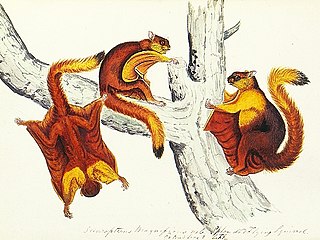
Hodgson's giant flying squirrel is a species of rodent in the family Sciuridae. This large flying squirrel lives in Himalayan forests in Asia. Like other flying squirrels, it is nocturnal and able to glide long distances between trees by spreading out its patagium, skin between its limbs.

The Bhutan giant flying squirrel, also known as the Gray's giant flying squirrel or noble giant flying squirrel, is a species of rodent in the family Sciuridae. This species lives in Himalayan forests and it is one of the largest flying squirrels. Like other flying squirrels, it is mainly nocturnal and able to glide long distances between trees by spreading out its patagium, skin between its limbs.

The Indian giant flying squirrel, also called the large brown flying squirrel or the common giant flying squirrel, is a species of rodent in the family Sciuridae. It is capable of gliding flight using a skin membrane, the patagium, stretched between front and hind legs. It is found in mainland Southeast and South Asia, and southern and central China.

The Japanese dwarf flying squirrel is one of two species of Old World flying squirrels in the genus Pteromys. During the day this squirrel hides in a hole, usually in a coniferous tree, emerging at night to feed.
The Mechuka giant flying squirrel is a species of rodent in the family Sciuridae. First described in 2007 from East Himalayan forests at altitudes of 1,500–2,500 m (4,900–8,200 ft) in the region of Mechuka of north-central Arunachal Pradesh in India, its taxonomic status and position is not fully resolved. it was originally described as P. nigra but has been replaced by mechukaensis because it was a primary homonym of P. nigra Wang 1981.
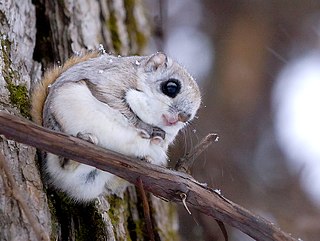
The Ezo flying squirrel or Ezo-momonga is a subspecies of the Siberian flying squirrel. It is endemic to Hokkaidō, Japan, part of the region once known as Ezo. In the legends of the local Ainu, the Ezo flying squirrel or A-kamui is a tutelary deity of children. Together with the Ezo chipmunk and Ezo squirrel, it is one of the three sciurids found on the island, to the north of Blakiston's Line, each having its own particular ecological niche.
